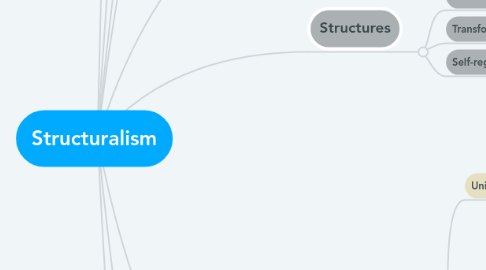
1. Semiotics
1.1. Sign system
1.1.1. Classes of signs
1.1.1.1. Index
1.1.1.1.1. Blood=Injury
1.1.1.2. Icon
1.1.1.2.1. Pablo´s Escobar picture
1.1.1.3. Symbol
1.1.1.3.1. Peace and love figure
2. Linguistic dimension
2.1. Ferdinand de Saussere
2.1.1. Langue
2.1.1.1. Structure of language
2.1.2. Parole
2.1.2.1. Individual utterances
2.1.3. Linguistic sign
2.1.3.1. Signifier
2.1.3.1.1. Sound image
2.1.3.2. Signified
2.1.3.2.1. Concept
3. Structural anthropology
3.1. Culture
3.1.1. Surface phenomena
3.1.2. Codified processes
3.1.2.1. Mate selection
3.1.2.2. Kinship ties
3.1.2.3. Initiation into adulthood
3.2. Myths
3.2.1. Make sense
3.2.1.1. of
3.2.1.1.1. The chaotic world
3.2.2. Mythemes
3.2.2.1. Subject-verb
4. Structures
4.1. Wholeness
4.1.1. Unit
4.2. Transformation
4.2.1. Dynamic system
4.3. Self-regulation
4.3.1. Transformation of a structure
5. Literature
5.1. Narrative dimension- Mythos of
5.1.1. Spring
5.1.1.1. Comedy
5.1.1.1.1. Triumph
5.1.2. Summer
5.1.2.1. Romance
5.1.2.1.1. Conflict
5.1.3. Autum
5.1.3.1. Tradegy
5.1.3.1.1. Catastrophe
5.1.4. Winter
5.1.4.1. Irony-satire
5.1.4.1.1. Anarchy
6. Greimas
6.1. Narratology
6.1.1. Structure of narrative
6.1.1.1. Plots formulas
6.1.1.1.1. Conflict and resolution
6.1.1.1.2. Struggle and reconcilation
6.1.1.1.3. Separation and union
6.1.1.2. Grammar
6.1.1.2.1. Actants
6.1.1.3. Sequences
6.1.1.3.1. Contractual
6.1.1.3.2. Performative
6.1.1.3.3. Disjuntive
7. Todorov
7.1. Analogy
7.1.1. Units of narrative
7.1.1.1. Characterization and plot
7.1.1.1.1. Characters
7.1.1.1.2. Characters´ attributes
7.1.1.1.3. Proposition
7.1.1.1.4. Sequence
7.1.2. Units of language
7.1.2.1. Parts of speech
7.1.2.1.1. Proper nouns
7.1.2.1.2. Verbs
7.1.2.1.3. Adjectives
7.1.2.1.4. Sentences
7.1.2.1.5. Paragraphs
7.1.3. Structural system
7.1.3.1. Negation
7.1.3.1.1. Absence of
7.1.3.2. Comparison
7.1.3.2.1. precense of
7.1.3.3. Modes
7.1.3.3.1. Qualification of
8. Genette
8.1. Narrative
8.1.1. Story
8.1.1.1. Series of episodes
8.1.2. Narrative
8.1.2.1. The text itself
8.1.3. Narration
8.1.3.1. The act of telling the story
9. They interac by means of
9.1. Tense
9.1.1. Arrangement of events
9.1.1.1. Order
9.1.1.1.1. relationship between
9.1.1.2. Duration
9.1.1.2.1. relationship between
9.1.1.3. Frequency
9.2. Mood
9.2.1. Atmosphere of the narrative
9.2.1.1. Distance
9.2.1.1.1. Precense of the narrator
9.2.1.2. Perspective
9.2.1.2.1. Point of view in the story
9.3. Voice
9.3.1. Narrator´s voice
9.3.1.1. Narrator-story
10. Culler
10.1. Literary interpratation
10.1.1. Codes and Rules
10.1.1.1. Convention of distance and impersonality
10.1.1.1.1. Literary assumptions
10.1.1.2. Naturalization
10.1.1.2.1. Transformation of texts
10.1.1.3. Significance
10.1.1.3.1. Assumption
10.1.1.4. metaphorical coherence
10.1.1.4.1. Metaphor
10.1.1.5. Thematic unity
10.1.1.5.1. Coherent theme

